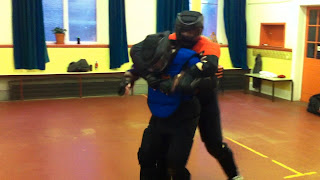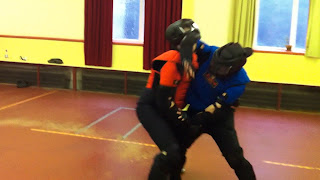Feedback from the 2011 BTEC Self-Defence Instructors Program

As posted by our UK-based affiliate, Ger O’Dea of Dynamis Training & Insight
“Our Dynamis Self Defence Instructor Certification 2011, in partnership with NFPS Ltd, was completed on the 29th July with a new cadre of Self-Defence Instructors graduating from the programme.
The instructor candidates came from the areas of Community Safety, Prison Services, Health Services, Mental Health Services, Victim Support and the self-defence community.
Each candidate had to complete an extensive programme of online learning about the Law, Managing Training and the Science and Psychology of high-stress encounters before attending the 3-day course. All this online learning and course content was provided by the National Federation for Personal Safety (NFPS Ltd.) as part of the BTEC certification requirements.
Once on-site, the candidates submitted their completed course workbook and engaged in classroom discussions of the pre-learned materials, which culminated on the second day with a written knowledge-check and on the third day with peer feedback on their presentations.
Meanwhile, world-class self-protection coach Tony Torres spent hours and hours with the group, imparting his highly effective and practical approach to breakaway, disengagement and self-defence. For many, his ‘behavioural’ approach to self-protection, based on the natural behaviours and attitudes of humans in conflict, opened up many new perspectives on how they could enable and empower their learners to be safer.
At various points in the training, to increase comfort and safety for the candidates, the lead trainers incorporated the use of impact-reduction training equipment from Spartan Training Gear, most notably the Hoplite Vest torso protector. Using this equipment allowed the training to become more dynamic and was instrumental in pointing out how intensity could be incrementally added to a training programme safely.
The training venue itself was selected to give the candidates a visceral experience of training in self-defence, as the physical skill development sessions were carried out in a full scenario-area designed to replicate a typical Scottish street scene. This level of ‘training fidelity’ with the real world was a central theme of the course.
Lead Trainer Gerard O’Dea prompted discussions in the classroom about the relevance of this behavioural method for instructors, providing commentary from the point of view of programme design and development with an eye to the legal and liability issues which may arise where behavioural issues are not incorporated into modern training.
The mix of theory, practice and high-level discussion was a great success and candidates remarked on many occasions that the course carried a very positive energy throughout.

The candidates offered their feedback in formal reflective submissions at the end of the course. A selection of their comments follows:
“Thoroughly enjoyed the course. It gave me numerous ideas and drills I can start to use with my students. Teaching standard was excellent and I’m very keen to attend future courses”
– Martial Arts Instructor, Edinburgh University
“Course provided me with knowledge, tools and skills I will take away and use. By the end I felt confident that I was going to be able to structure, design and give a class. The presentation to peers was actually very helpful in pulling it all together”
– Self-Defence Course Leader, HM Treasury
“A greatly presented course with a high standard throughout. Thoroughly enjoyed training with Gerard O’Dea and Tony Torres”.
– Martial Arts Instructor, London
“Found both Tony & Gerard to be very professional and highly competent. Behavioural Self-Protection concepts were new to me – enjoyed learning them and training them. Very impressed by these 3 days. Thanks”
– Martial Arts Instructor, Glasgow
“Tony and Gerard were very helpful. Would attend again!”
– Team Member, Community Safety Team
“The course was very well run, pitched at the right level for the candidates. I found the whole course interesting – the easy way in which the techniques move into one another was particularly interesting. The coaches were helpful and very professional.”
– Physical Intervention and Breakaway Instructor, NHS
“All parts fitted well together with the video/online presentations supporting the physical skills aspect. Both trainers were very knowledgeable, enthusiastic and related well to the delegates. Course is excellent in this format.”
– Martial Arts Instructor, Stirling
“The course was run very professionally and both instructors were able to answer all questions. The physical skills part was most interesting – thank you very much for spending the time to help us.”
– Prevention and Management of Violence and Aggression Lead, NHS
“The course was well structured and full of information and practical practice. It has been one of the most beneficial courses for self-defence for me”
– Senior Control & Restraint Instructor, Prison Service
“Thank you both very much! I found the course really stimulating and empowering!
– Conflict Management Trainer, Private Company
“I would like to thank Gerard and Tony on the excellent delivery of the most knowledgeable and interesting course I have attended”
– Team Member, Community Safety Team
“Fantastic course, engagingly delivered – many thanks!”
– Mental Health Nurse and Violence & Aggression Management Lead
Dynamis, in association with NFPS Ltd., will be offering future Instructor Qualification courses in Physical Intervention, Restraint, Breakaway and Self-Defence.
If you are interested to gain a BTEC vocational qualification and all of the knowledge which is incorporated on these courses, make sure to register your interest by e-mailing gerard@dynamis-insight.com to be notified of future training and certification opportunities.”


 Spartan Training Gear‘s corporate allies, Dynamis Training and The Functional Edge System are teaming up for the first time to offer a BTEC Level 3 Advanced Award in Self Defence Instruction Program in Edinburgh, Scotland on July 27-29, 2011
Spartan Training Gear‘s corporate allies, Dynamis Training and The Functional Edge System are teaming up for the first time to offer a BTEC Level 3 Advanced Award in Self Defence Instruction Program in Edinburgh, Scotland on July 27-29, 2011